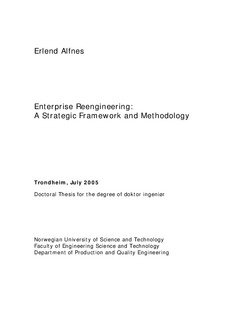| dc.description.abstract | Manufacturing companies find themselves, whether they like it or not, in a more global and changing reality. Fiercer competition, dynamic markets, new consumer habits, stronger environmental regulations, and new technological possibilities, are forcing manufacturing companies to change. The practical effects for European manufacturers are 1) new and innovative products, 2) global value chains, 3) automation, and, 4) a shift from products to solutions. This research is addressing the changes needed for operations in a single enterprise (a group of departments, a plant, or a group of closely located plants), to take advantage of the competitive situation.
For such “internal” operations, the new challenges require changes both in technology and practices. The main concern of this research is the practices, and how a reengineering of manufacturing and office operations can improve performance. The choice of scope is based on the assumption that operations activities are a major source for competitiveness. To reengineer operations activities in processes rather than functions, and to implement best practices wherever appropriate, can therefore provide dramatic competitive improvements.
The overall objective of this research is to:
• establish enterprise reengineering as an approach that enables manufacturing enterprises to achieve fit between market requirements and operations capabilities.
Enterprise reengineering is viewed as model-based and strategy driven approach that enables manufacturers to realise the “soft” or infrastructural aspects of an operations strategy. To support such reengineering efforts, enterprises are viewed not only from a process perspective but also from a resource, materials, information, organisations, and control perspective. Modelling and analysing enterprises from these perspectives can support their effort to implement best practices, and ensure that the practices are combined in a way that supports the overall business strategy.
The overall objective is divided into more specific objectives:
• To develop a strategic framework for enterprise reengineering
• To develop a consistent and practical enterprise reengineering methodology to support the formulation and realisation of operations strategies
• To develop architecture for conceptual enterprise modelling that ensures a coherent, decomposed, and holistic picture of enterprise operations
• To establish “flow manufacturing” as a (optional) best practice programme for enterprise reengineering
Together, the strategic framework, the methodology, and the modelling architecture should enable enterprises to achieve their performance objectives through an enterprise reengineering effort. In cases where an enterprise mapping and analysis concludes that improvements in manufacturing planning and control, order management, layout and flow, or inventory, should be performed, the flow manufacturing programme should provide practical guidance and a set of principles to support reengineering.
In order to achieve these objectives, the following issues are reviewed in this thesis:
1) operations strategy, 2) enterprise reengineering, 3) flow manufacturing, 4) enterprise modelling, and, 5) change management. Based on these literature studies, a strategic framework, a methodology, a modelling architecture for enterprise reengineering and a flow manufacturing programme are proposed.
The major outcome of this research is an enterprise reengineering methodology, which includes strategic planning, and operations mapping, analysis, design, and implementation. The methodology consists of the following models, principles, and tools:
• A operations strategy checklist
• Four flow manufacturing design principles
• An architecture for conceptual enterprise modelling
• Seven change management principles
• A procedural guide for enterprise reengineering
• An operations performance audit sheet
• A five-step approach to flow manufacturing reengineering
The research is based on a case study of HÅG Fast, a very successful enterprise reengineering project carried out in 1991-1992. The case study demonstrates the usefulness of the methodology to analyse and understand enterprises, and the dramatic improvements in performance that can be achieved by implementing flow manufacturing practices. In addition, the enterprise reengineering methodology has been proved useful in several field studies. | nb_NO |
